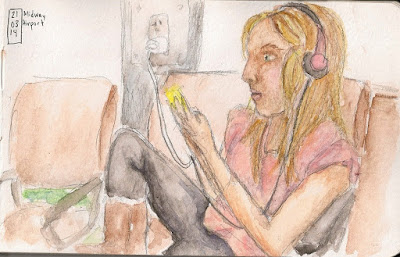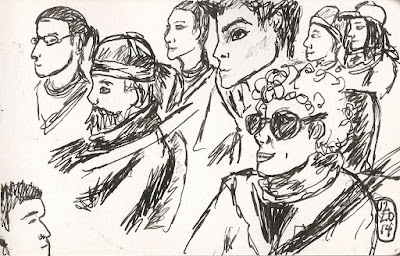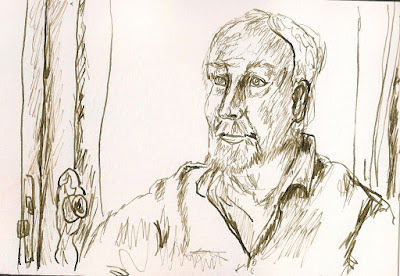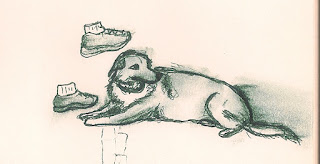In a few weeks we'll be thinking about 2016 and what we want to change or how we want to improve our sketching practice in the next year. But right now, it can feel like the worst time of the year for sketching.
Here are a few tips to help you reconsider your reasons for not sketching this Holiday season.
"I'm going to be traveling a lot…"
Perfect!
 |
| Sketch of girl waiting at Midway Airport |
Airports are famously good places for the Urban Sketcher to capture scenes. Whether you sketch other passengers waiting to board, people running past your boarding area to their own flights, your in-flight snack, or something else you spy, air plane travel is a great time to sketch.
 |
| collage of faces from a looong car ride |
If you're traveling by bus or riding in the car, you're also in luck.
This can be a great time to practice quickly capturing people. One year
on our long drive home I filled a notebook page with faces of the
drivers and passengers of the cars around us. Or if people aren't your
cup of tea, why not make thumbnails of the landscapes whizzing past?
(Please don't try to draw while driving. I know it is tempting, but it's
not worth it!)
"I'll just be sitting around with family or something…"
Lovely!
If you'll be seated around a table for hours, why not use paper place mats? Less washing for the household, and great opportunities to sketch those around you. As an added bonus, other folks around the table might want to make their own renderings of the company!
When we celebrate holidays with my husband's family things go back and forth between wild, when all twenty-something folks are in a single room, and quiet in the evenings or mornings while folks are sitting around talking. If you're at similar events, take advantage of those times: try gesture drawings of the full moments and more thoughtful sketches when things quiet down.
 |
| Sketch of Grandpop in between stories |
"I don't feel comfortable just drawing people I'm in the room with…"
 |
| I was just studying shoes, but the dog stole the show! |
Well, part of being an Urban Sketcher is overcoming your fear of sketching in public. But, if you need some extra help this year, why not try having a theme? Maybe make this a time to practice drawing the folds in clothing, or maybe more specifically the way pants fold near the shoe. If you have a hard time with hair, sketch everyone's hair. You won't have to worry about trying faces or hands (unless that's what you want to focus on!) but you'll be helping yourself feel more comfortable with drawing people in the future.
Ok, so you really, really can't draw anything on anyone this year? Urban Sketching isn't just about people, so why not try another approach. Instead of sketching the people in the room, why not sketch the room. Just remember, when we sketch, we're telling a story about the place. So, leave in the crumpled wrapping paper or even the dirty dishes on the table.
Do you have a plan for sketching the Holidays? If so, I'd love to hear it & either way, I'm looking forward to seeing glimpses of what your Holidays look like over in our
Facebook group, or on
Instagram.

























